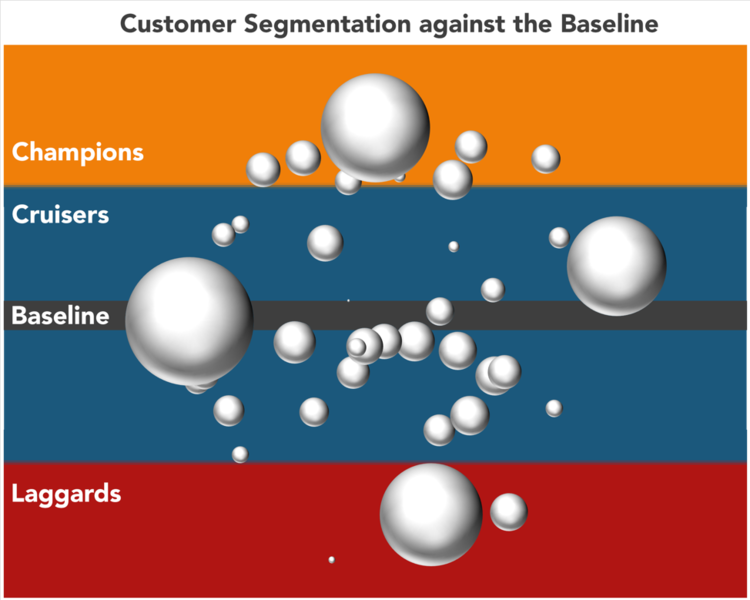Leverage your Champions
Books describing business champions routinely top the New York Times Best Sellers list because we are curious to learn how some executives excel. I use the same competitive spirit within my customer portfolio to increase adoption, business value achievement and net revenue by identifying champions and pointing other customers to their achievements.
Success Story: One of my customers was “cruising along.” Good adoption, good executive sponsorship and a solid relationship. They had the potential to go from good to great, but they were hesitant to embark on an effort with (in their minds) questionable ROI.
I put them in touch with one of our champions and they witnessed first-hand what was achievable. They added premium capabilities and made our solution a reference architecture for the entire enterprise. The account value for us more than tripled over 2 years, all because of one introduction.
Here is my process for establishing a baseline, defining playbooks and identifying champions.
STEP 1: SET THE BASELINE
When I define a customer journey, I generally have a good idea what the typical customer should achieve, when, and how. It contains key milestones and dates like:
- Day 5: First login
- Day 10: Configuration complete
- Day 90: Executive Business Review (EBR) 1 – 75% of target business value achieved
- Day 270: EBR 2 – 100% of business value achieved
As you think about your own customer journey and timing, these tips can help you avoid common pitfalls:
a) Confirm the dates and goals with your high-touch and low-touch customers directly. You don’t need a fantasy league version of the best possible circumstances, but a realistic set of expectations. For tech-touch customers, provide a recommendation that sets some expectations, and encourage your customers to reach out to you if they are falling behind.
b) Over time you may find that you need to set different goals and timelines for various segments, customer sizes, and product configurations.
c) Run your program in “silent mode” for a period of time and validate your assumptions against your actual customer base. If customers aren’t following the timeline closely, it is an indication that you may need to adjust.
d) Don’t assume your customers are on track. Ideally, implement in-app telemetry that is linked to these milestones. Nothing is worse for a struggling new customer than an “Congratulations e-mail” from your marketing automation system when they are frustrated with getting even simple steps completed.
STEP 2: DEFINE THE PLAYBOOKS
Once the baseline is established, three types of customer typically surface. I call them Champions, Cruisers, and Laggards.

Champions: At the top are my dream customers: they exceed all expectations, accelerate their onboarding, use all the bells and whistles AND surpass their business value targets. These are my champions and deserve dedicated attention:
a) Celebrate their achievements as publicly as possible: press releases, keynote speaker engagements, webinars, reference calls, innovation awards. For those who cannot be named publicly, have an internal celebration to acknowledge the sponsor and other core members.
b) Synthesize their unique “essence”: Did they have a higher-level executive sponsor, are they integrated with a specific software package, or did they have a dedicated project manager? This knowledge is priceless for developing lead qualification criteria, sales plays, best practices, and success playbooks.
c) Define a reference model for other customers and users to follow. Whoever is not in your top layer may want to get there, and now your team can guide them together to win the pot of gold at the end of the rainbow.
d) Invite them to your customer council. They already pushed the boundaries of your solution and were ready for more. Their proposals drive innovation, and they are motivated to adopt the new capabilities. They support the marketing of these enhancements as vocal advocates.
Cruisers: Hopefully the majority of your customers achieve the business value they expected within a typical timeframe. Cruisers are customers on a stable course, and they are perfect targets to connect with a Champion to drive even stronger performance.
a) Assess if the customer is able to achieve more. Maybe they have done all they can with their resources.
b) Focus primarily on maximizing the customer’s value, and explore subscription increases or new products as a secondary objective. Maximizing customer value fends off churn better than anything else.
Laggards: The third band of customers lags behind general expectations and holds the highest churn risk. How to rescue customers in distress is a separate discussion and worth its own future blog post.
STEP 3: SEGMENTATION
With these playbooks in hand, I stack-rank customers along the baseline. This enables you to consider the customer’s actual status. Combined with the other segmentation of your customers, along with their business value definitions, you have the tools in place to pair like-minded customers along the same reference model.
. . . . .
Once I adopted this three-step process with my customers and had it up and running for a few quarters, I was able to embellish the customer journey and playbooks with the knowledge I gained.











